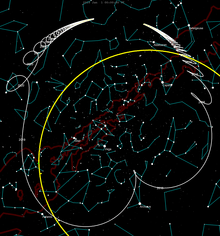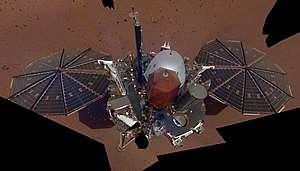C/2018 C2 (Lemmon)
C/2018 C2 (Lemmon) is a hyperbolic comet (previously classified as A/2018 C2, a hyperbolic asteroid). It was first observed on 5 February 2018 by the Mount Lemmon Survey conducted at the Mount Lemmon Observatory near Tucson, Arizona, in the United States.[1] The discovery was announced on 4 March 2018 along with another hyperbolic object, A/2017 U7.[2] Based on the absolute magnitude of 15.1, it may measure several kilometers in diameter.[4] On 22 March 2018 it was determined to be a hyperbolic comet.[5]
 Annual motion through solar system | |
| Discovery [1][2] | |
|---|---|
| Discovered by | Mount Lemmon Srvy. |
| Discovery site | Mount Lemmon Obs. |
| Discovery date | 5 February 2018 (first observed only) |
| Designations | |
| C/2018 C2 (Lemmon) | |
| ZC82561, A/2018 C2 | |
| hyperbolic comet [3] extended centaur damocloid | |
| Orbital characteristics [3] | |
| Epoch 15 February 2018 (JD 2458164.5) | |
| Uncertainty parameter n.a. | |
| Observation arc | 30 days |
| Perihelion | 1.9563±0.0007 AU |
| −1300±500 AU[lower-alpha 1] | |
| Eccentricity | 1.0015±0.0005 0.99905 (Barycentric epoch 2200) |
| n.a. | |
| 0° 0m 0.072s / day | |
| Inclination | 34.452° |
| 91.14° | |
| 134.15° | |
| Earth MOID | 1.061 AU |
| Jupiter MOID | 1.405 AU |
| Physical characteristics | |
| Dimensions | 1.7–7.6 km (assumed) |
| 19.0 (March 2018) | |
| 15.1±0.63 | |
Orbit


While near perihelion, A/2018 C2's heliocentric orbit is not bound to the Solar System, unlike ʻOumuamua, it is probably not an interstellar object. The heliocentric eccentricity drops below 1 starting with an epoch of July 2022, when it is 12.9 AU from the Sun, making the orbit bound to the Sun before it leaves the planetary region of the Solar System. The more stable barycentric orbit of A/2018 C2, shows that it is only a very distant small Solar System body, approaching as far as 20,000 ± 80,000 AU from the Sun, around the distance of the Oort Cloud. It had an orbital period of roughly 1 million years until the current approach to the Solar System, where perturbations will shorten the orbit drastically to 2,900 ± 1,700 AU, with an orbital period of 55,000 years.[lower-alpha 2] These numbers will become better refined as the observation arc becomes longer than 30 days.
As of March 2018, A/2018 C2 is inbound 2.2 AU (330,000,000 km; 200,000,000 mi) from the Sun.[2] A/2018 C2 makes closest approach to the Sun on 2 June 2018 at a distance of 1.9 AU (outside the orbit of Mars).[3] Since this object out gassed generating a cometary coma while near the inner solar system, it was reclassified as a hyperbolic comet.[6]
Notes
- Objects on hyperbolic trajectories have negative semimajor axis, giving them a positive orbital energy.
- Soln.date: 2018-Mar-04: EC= 0.99905 (Barycentric epoch 2200)
References
- "A/2018 C2". Minor Planet Center. Retrieved 5 March 2018.
- "MPEC 2018-E18 : A/2018 C2". IAU Minor Planet Center. 4 March 2018. Retrieved 4 March 2018. (AK18C020)
- "JPL Small-Body Database Browser: (A/2018 C2)" (2018-02-27 last obs.). Jet Propulsion Laboratory. Archived from the original on 5 March 2018. Retrieved 5 March 2018.
- "Asteroid Size Estimator". Jet Propulsion Laboratory. Retrieved 5 March 2018.
- "MPEC 2018-F136: COMET C/2018 C2 (Lemmon)". IAU Minor Planet Center. 28 March 2018. Retrieved 28 March 2018. (CK18C020)
- "JPL Small-Body Database Search Engine: comets and e > 1". Jet Propulsion Laboratory Solar System Dynamics. Retrieved 4 March 2018.

